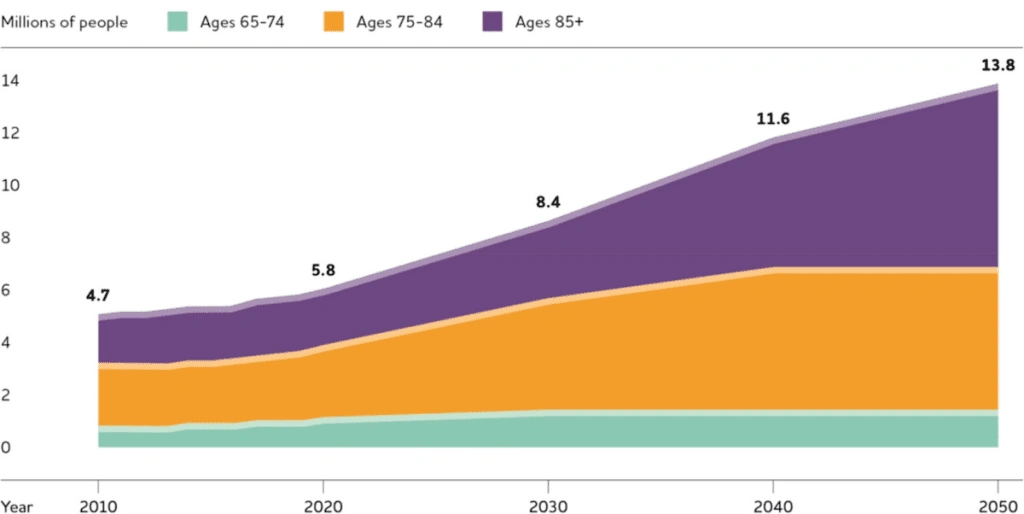Neurological diseases and disorders are perhaps more prevalent than ever, characterized by the progressively impaired functioning of nerve cells in the central and peripheral nervous systems.
Alzheimer’s and Parkinson’s disease are the most common degenerative neurodegenerative diseases, but there are hundreds with varying and overlapping symptoms and prognoses, and many are poorly understood.
The UN estimates some 1 in 6 people suffer from a neurological disorder, and rates are generally increasing across the US, UK, and Europe – especially for Alzheimer’s disease.

Machine learning is uncovering previously-unknown information about neurodegenerative disease progression. Findings provide researchers with the data they need to better understand diseases, create and refine clinical trials, and devise precision treatment and management plans.
Machine Learning Helps Researchers Understand Neurodegenerative Disease
Machine learning (ML) and artificial intelligence (AI) are helping researchers unlock new insights into the cause, effects, and progression of neurodegenerative diseases.
For example, researchers from the Massachusetts Institute of Technology (MIT) recently developed a machine learning model to identify the pattern of amyotrophic lateral sclerosis (ALS) progression. The study, published in Nature, helped clarify the differences between linear and non-linear patterns of ALS progression and health decline.ALS is a complex disease with numerous underlying mechanisms, many of which we don’t fully understand
Another machine learning model utilized computer vision (CV) to assist clinicians in assessing facial palsy relating to neurological disease. The study, published in Plastic and Reconstructive Surgery provided a means to assess different grades of facial paralysis objectively.
Here, we can see how ML assists two vastly different research agendas – flexibility is one of the technology’s greatest credentials. Machine learning has many applications in healthcare – read more use cases here.
Analyzing Disease Progression with Machine Learning
Amyotrophic lateral sclerosis (ALS), also known as motor neuron disease or Lou Gehrig’s disease, is a complex neurodegenerative disease that causes progressive decline and death of the nerve cells in the brain and spinal cord.
Currently, the disease is incurable, and treatments are generally poor. We know that progression and manifestations vary considerably; for some, the disease progresses rapidly over the course of months, and for others, it can take years.
The late eminent physicist and cosmologist Stephen Hawking is probably the longest-lived individual with ALS – he was diagnosed at 21 and lived until he was 76.
This is exceptional, and while some research indicates a slower disease trajectory with earlier onset, no one really understands why some with ALS live for so long and others for so little.

Machine learning is helping researchers understand ALS disease prognosis, and their findings might help develop similar techniques for Alzheimer’s and Parkinson’s.
Identifying Nonlinear Disease Progression
A couple of decades ago, most believed neurodegenerative diseases followed a relatively linear pattern. We now know that isn’t the case.
MIT’s ALS model aims to clarify ALS disease patterns, “The question we were asking is: can we use machine learning to identify if, and to what extent, those types of consistent patterns across individuals exist?” – Divya Ramamoorthy PhD ’22, MIT.
They achieved this using unsupervised machine learning. The model employed Gaussian process regression and Dirichlet process clustering. Models identified and inferred health trajectories using patient data, grouping similar trajectories into similar groups. The model didn’t assume linearity.
The model used five ALS datasets from clinical trials and observational studies, which use the ALS functional rating scale revised (ALSFRS-R). This is a global metric of neurological impairment.
The model identified four primary patterns of ALS progression; unstable moderate progression, sigmoidal fast progression, stable slow progression, and unstable slow progression. Each contains non-linear characteristics, which the model captures, including when patients experience a drastic drop in health called the “functional cliff”.
By applying ML techniques to ALS data, researchers gained an empirically driven account of ALS’ non-linearities. This helps guide future research, clinical trials, patient and clinician education, and management plans.
Applying Machine Learning to Alzheimer’s and Parkinson’s
Alzheimer’s and Parkinson’s are similar in that disease progression varies considerably between patients. Understanding what trajectory a patient is on is tricky, thus making management tougher for both patients and clinicians.
The MIT study shows promise for identifying patterns in diseases other than ALS. For example, their analysis of Parkinson’s uncovered a relationship between disease progression, symptoms, and disease phenotypes.
This approach fits well with molecular biology, where ML algorithms designed to map progression can be combined and compared with molecular data to discover correlations between disease trajectory and molecular types and subtypes of the disease.
You could start with the symptoms and map molecular differences to symptomatic differences or start with the molecules and map disease trajectories to different disease subtypes.
This kind of application of machine learning bridges gaps in human and machine intelligence to solve research bottlenecks. We can observe similar applications of AI elsewhere in science, such as using ML models to decipher ancient languages. AI is even being used to identify scientific research gaps to inform researchers of innovative pathways to pursue.
Developing novel models to enhance, augment and support human learning and research is where AI and ML tech thrives. There is hope that even some of humanity’s most complex and poorly understood diseases – like ALS – can be unraveled with the help of machine learning.






